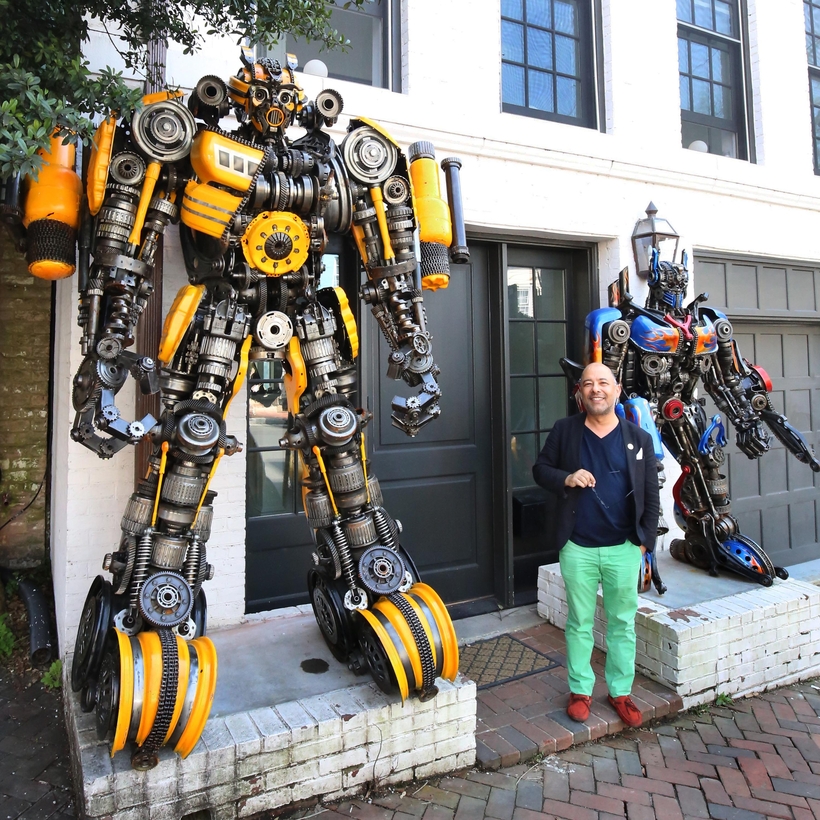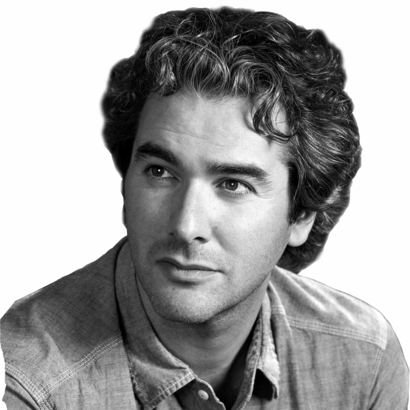Georgetown, the tony Washington, D.C., neighborhood famous for its narrow streets, Colonial-era houses, and old money, is not known for being welcoming to outsiders. Legend has it that its residents blocked a Metro station’s being built there in the 1970s because they didn’t want the wrong sort of people gaining easy access.
Now a different sort of interloper has appeared: two giant statues of Transformers have landed on picturesque Prospect Street. For those unfamiliar with them, Transformers are a warring race of sentient, shape-shifting robots from the planet Cybertron that have appeared in movies, comic books, and on lunch boxes since the early 1980s. Usually locked in an eternal battle against the evil Decepticons, the virtuous Autobots, in turn, face a new and remorseless enemy of their own: the Georgetown crowd.
The arrival of 6-foot-tall Optimus Prime and 10-foot-tall Bumblebee is due to Dr. Newton Howard, a professor of brain sciences and neurosurgery at nearby Georgetown University. Dr. Howard placed the oversize Autobots in front of his $4 million town house this January on the site where a pair of large planters had previously stood. He had intended it as a gesture to help cheer up kids in the area during the pandemic. “I had them inside my house and thought it’s selfish of me to keep them to myself. Why not put them outside?” For Dr. Howard, who specializes in brain implants to alleviate Parkinson’s and Alzheimer’s disease, the Transformers symbolize the idea of “integrating human and machine together with the role of restoring human dignity.” Unfortunately, the other residents of his street don’t see them in quite that way.
At a recent Advisory Neighborhood Commission (A.N.C.) meeting, Dr. Howard’s neighbor Luke Russert, the 35-year-old son of the late newsman Tim Russert, called the Transformers a “nuisance” and an “eyesore” and demanded they should come down, arguing, “What’s to stop someone from putting up a statue of Joseph Stalin?” Meanwhile, Catherine Emmerson, the co-founder of the Prospect Street Citizens Association, which counted Dr. Howard among its donors, worried that they would diminish home values and also attract “random groups of people who are not practicing social distancing.”
Usually locked in an eternal battle against the evil Decepticons, the virtuous Autobots face a new and remorseless enemy: the Georgetown crowd.

Admittedly, and despite their shape-shifting skill, the statues are somewhat incongruous with their genteel surroundings. Yet the A.N.C., seemingly wishing to avoid a fight over the robots’ aesthetic merits, last month rejected Howard’s request for a permit and referred him to the Old Georgetown Board, which advises the U.S. Commission of Fine Arts, a planning body as powerful and mirthless as Megatron, leader of the Decepticons. And so last week, despite supporting letters from many of Georgetown’s under-10 set begging them to spare the Autobots, the board declared the statues “not appropriate for a historic district,” and they will now likely have to come down. Dr. Howard has sworn to keep fighting “to the highest level of our court system.”
“More than meets the eye” went the Transformers’ tagline, and the same could be said of Dr. Howard. He’s worked with governments across the world on counter-terrorism. He heads a research program at Oxford University. Google licenses his technology. He was even responsible for one of the first rapid saliva tests for the coronavirus. His Georgetown neighbors may have taste and tradition on their side, but—to mix comic-book franchises—they have picked a fight with Tony Stark.
George Pendle is a New York–based writer. He is the author of several books, including Death: A Life and Happy Failure


